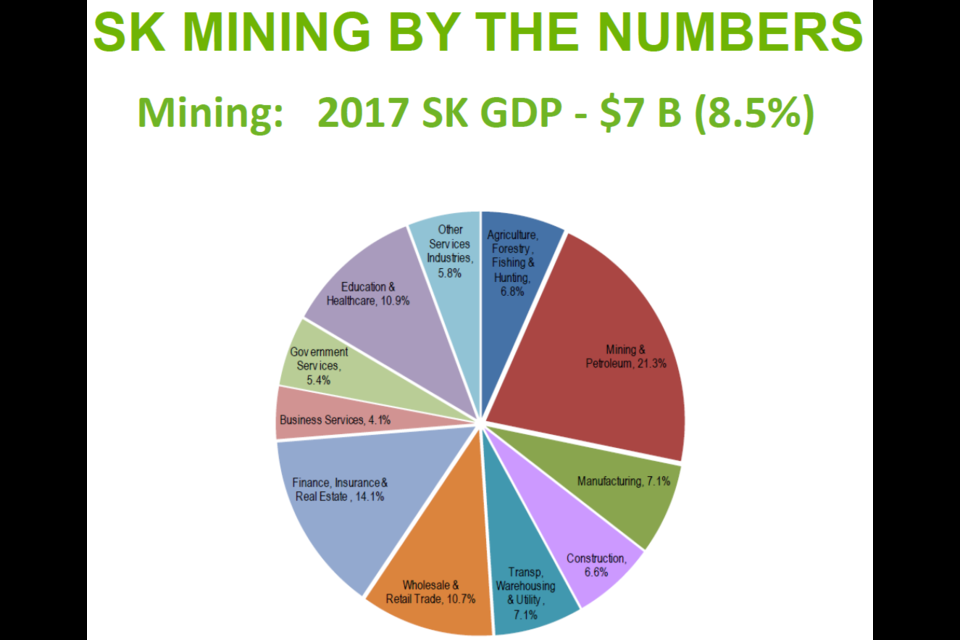More than 30,000 people in Saskatchewan are employed directly or indirectly in the mining industry, an area the mining sector says is an important economic driver of the economy.
Saskatchewan’s 23 mining operations directly employ more than 12,400 individuals, with those employees receiving wages totalling $1.4 billion in 2017, explained Pamela Schwann, president of the Saskatchewan Mining Association (SMA). For every direct job in the industry, there are at least two more jobs in the supply and service side.
Schwann presented numerous information about how the mining industry affects Saskatchewan during her talk to the Moose Jaw Chamber of Commerce on May 29.
Mineral production
Saskatchewan was the fourth-highest mineral producing jurisdiction in Canada in 2017, creating $5.7 billion in revenue. Ontario led the pack at $9.86 billion, followed by British Columbia at $8.84 billion and Quebec at $8.6 billion.
“We have been No. 1 in Canada, and I took great pleasure in bugging my colleagues in Ontario about when we were No. 1, but that was when potash was $900 per tonne,” Schwann said.
The total value of mineral production in Canada last year increased to $47 billion. Gold was the No. 1 commodity by value of production, at $9.6 billion. Potash and uranium came in at third place ($5.7 billion) and eighth place ($660 million) respectively.
The Fraser Institute has ranked Saskatchewan as the third-best jurisdiction in the world — and No. 1 in Canada — for its mining investment attractiveness.
In 2018, Saskatchewan was the top place in Canada for mineral investment attraction and No. 3 globally; the top potash producer in Canada, while providing 30 per cent of all global productions; the second-highest uranium producer in the country, while providing 22 per cent of all global productions; the top industrial employer of Aboriginal peoples in Canada; the fourth-best place in Canada for exploration, at $247 million; and the leading client of rail and vessel transport by value and volume.
Mining and petroleum production contributed $7 billion to Saskatchewan’s economy in 2017, which was about 21.3 per cent to the province’s overall budget.
“We need the primary wealth creators to drive the economy. Mining is that driver,” Schwann said.
Mining operations for gold produced a record 95,602 ounces (2,710.3 kilograms) last year at the Seabee Mine in northern Saskatchewan. Fort a la Corne, east of Prince Albert, is the world’s largest diamond-bearing kimberlite field.
“The deposit is just so large, it’s hard to assess what the grade and quality of the diamonds are,” said Schwann. It would take $3 billion to bring that deposit into production.
Roughly 21 per cent of Saskatchewan mine employees — or more than 2,600 people — are Aboriginal. In 2017, Aboriginal-owned businesses provided $649 million in goods and services to mining operations in the province.
“They are great ambassadors for the mining sector,” said Schwann.
Mining operations contributed more than $22 million in social and community donations last year, to organizations such as STARS air ambulance, the Jim Pattison Children’s Hospital, breakfast clubs and food banks, Habitat for Humanity, Children’s Wish Foundation, and Souls Harbour Rescue Mission.
More than $25 billion in capital expansions were made from 2008 to 2015 in the province. There are 11 mines producing potash and three companies — Nutrien, Mosaic, and K+S — devoted to this resource. Last year these mines produced 22.5 million tonnes of potash.
Saskatchewan produces 100 per cent of Canada’s uranium. Last year 18.2 million tonnes of uranium was produced, which is about a 50-per-cent decrease from the previous year. However, there is only one operational uranium mine in the province, at Cigar Lake/McLean Lake.
Forty-four per cent of Saskatchewan’s primary baseload power is from coal. The carbon capture and sequestration project — built for $1.4 billion — in Estevan is supposed to capture two million tonnes of carbon every year and sequester it underground, said Schwann. This is equal to capturing emissions from 500,000 cars.




